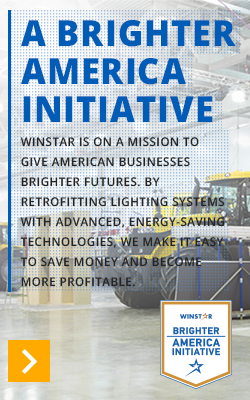Reduced Energy Consumption
One of the most important advantages of using LEDs is the energy they save. Compare the energy consumption of LEDs and incandescent lamps to see how the carbon footprint of a building’s lighting can be reduced by 85% by choosing LED replacements.
- Ratio of Energy to Carbon Emissions: 1 kWh of electricity = 1.34 lbs (610 g) of CO2 emissions
- Incandescent Bulbs: A 40-Watt bulb operating 10 hours/day will emit 196 lbs (89 kg) of CO2 emissions annually
- LEDs: A 6-Watt LED operations 10 hours/day will emit 30 lbs (14 kg) of CO2 emissions annually
Sustainable Designs
Offering incredible efficiencies compared to any other type of lighting solution, LEDs have the potential to attain significant levels of sustainability for both new and existing buildings. Consider these comparisons:
- One 6-Watt LED emits 450-650 lumens, the equivalent of a 40-Watt incandescent bulb
- A 40-Watt incandescent bulb has a life span of 1,000 hours
- A 6-Watt LED has a life span of 50,000 hours
Clearly LEDs deliver greater efficiencies with much longer life spans compared to conventional lighting, offering building owners a valuable solution for increasing operational sustainability.
Economically Sound
While LEDs have a higher up-front investment cost, they offer substantial savings because of their extended lifecycles and much lower energy consumption. LEDs demand an increased initial investment because of the advanced manufacturing processes required. During the production of LEDs, an expensive sapphire substrate is combined with a mirror-like collector within each semiconductor to reflect light that would otherwise be wasted. Yet it’s because of this feature that LEDs are so efficient. Today, high-end LEDs are available with efficiencies of 80-100 lumens/10 Watts or 800 LM, and inexpensive models are available at 50 lumens/Watt.
Non-Hazardous
Since LEDs do not contain any harmful gases such as the heavy metal mercury (a potent neurotoxin found in fluorescent lamps), they are far less toxic to manufacture than fluorescent lamps. Likewise, while fluorescent tubes require special disposal handling to protect against mercury exposure, LEDs pose no end of life hazards and in fact, are completely recyclable.
Cool Illumination
While incandescent lamps use 90% of the energy they consume to release 85 BTU/hour of heat energy, LEDs radiate virtually no heat at only 3.4 BTU/hour. Not only does this ensure longer life (they won’t overheat and burn out), it also eliminates any risk of fire or burns, and lowers air conditioning costs in the buildings in which they’re installed.


